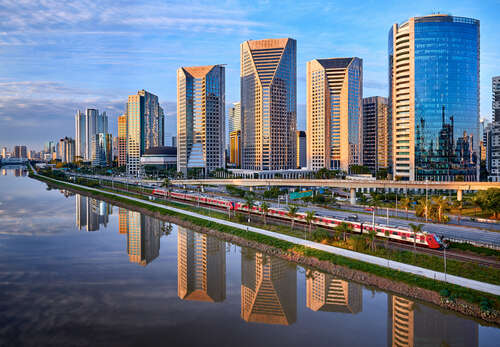
South America, a continent painted with rich hues of history, culture and unparalleled geographical splendour, boasts some of the world’s most dynamic and largest cities.

These metropolises, each with its unique story and rhythm, stand as living testaments to the region’s evolution over centuries. From the bustling avenues of São Paulo to the neoclassical realms of Buenos Aires; from Rio’s sun-drenched beaches to Lima’s culinary wonders, each city plays a part in the continent’s larger narrative.
City Monitor journeys through South America’s largest cities, using the latest demography reports.
São Paulo, Brazil – population: 21.486 million
São Paulo stands as the epitome of Brazil’s rapid urbanisation. Originally founded in 1554 by Jesuit missionaries, the city has grown exponentially, metamorphosing into South America’s largest metropolis. Today, São Paulo is not only Brazil‘s economic heartbeat but also a melting pot of cultures. Its skyline, dotted with skyscrapers, speaks of its contemporary significance, while its cultural venues, including the São Paulo Museum of Art and the São Paulo Symphony Orchestra, highlight the city’s dedication to the arts. The city is renowned for its gourmet restaurants, vibrant nightlife, and as the host of the São Paulo Fashion Week, the most important fashion event in Latin America.
Buenos Aires, Argentina – population: 15.748 million
Buenos Aires, or the ‘Paris of South America’, wears its European influences on its sleeve. Established in 1536, the city’s name translates to ‘Good Airs’, reflective of the region’s favourable winds. Its history is a cocktail of European migrations, especially Spanish and Italian, which is evident in its architecture, food and culture. Today, Buenos Aires is recognised for its tango music and dance, thriving theatre district, and as the birthplace of Pope Francis. A stroll down its avenues, like the iconic Avenida 9 de Julio, offers a panoramic view of its historical and modern coexistence.
Rio de Janeiro, Brazil – population: 12.306 million
Draped between mountains and the azure Atlantic, Rio de Janeiro is a city of natural beauty. Founded in 1565 by the Portuguese, Rio served as the capital of Brazil until 1960. Best known for its Carnival festival, samba rhythms, and the iconic Christ the Redeemer statue, the city stands as a symbol of Brazil’s zest. Copacabana and Ipanema are among the world’s most famous beaches, and the city’s juxtaposition of urban life against a backdrop of natural beauty is well-noted by tourists.
Lima, Peru – population: 10.556 million
Overlooking the Pacific Ocean, Lima was established in 1535 by Spanish conquistador Francisco Pizarro. Often referred to as the ‘City of Kings’, Lima is a blend of colonial heritage and modern-day urbanisation. As a gastronomic capital of Peru, Lima is celebrated for its diverse culinary scene, incorporating indigenous, Spanish, African and Asian flavours. It’s also the gateway to the ancient Incan city of Machu Picchu.
Bogotá, Colombia – population: 10.252 million
Resting high in the Andean plateau, Bogotá, founded in 1538, is Colombia’s largest city. A city of contrasts, Bogotá combines colonial-era churches and plazas with towering modern structures. The Gold Museum, housing the world’s largest collection of pre-Hispanic gold artefacts, and the vibrant district of La Candelaria, is among its most prized attractions. Today, the city stands as a testament to Colombia’s resilience and its renaissance from tumultuous times.
Santiago, Chile – population: 7.099 million
Nestled amidst the Andes, Santiago, founded in 1541, is the cultural, political, and financial centre of Chile. The city’s rich history is evident in its neoclassical cathedrals and buildings, while its modernity shines through its expanding metro system and skyscrapers. Renowned for its wineries, Santiago is also a hub for Chilean cuisine and arts, with venues like the Museo Chileno de Arte Precolombino showcasing indigenous art.
Recife, Brazil – population: 3.866 million
Often termed the ‘Venice of Brazil’ due to its numerous waterways, Recife was established in 1537. The city, with its vibrant cultural scene, is known for its Frevo music, Carnival celebrations, and stunning beaches. Moreover, the Historic Center of Olinda, a Unesco World Heritage Site, is a stone’s throw away, making Recife a significant tourist attraction.
Porto Alegre, Brazil – population: 3.504 million
Founded in 1772, Porto Alegre is a hub of culture and commerce in Brazil’s southern region. Its diverse European, Arab and African influences have sculpted its unique identity. The city is particularly known for its literary arts, hosting the Porto Alegre Book Fair annually, one of the largest of its kind in the world.
Fortaleza, Brazil – population: 3.415 million
Bathed by the Atlantic, Fortaleza was founded in 1726. Today, it is celebrated for its extensive coastal line, dotted with beaches like Praia do Futuro. The city’s rich tapestry of history, culture, and modernity is evident in its cathedrals, theatres, and shopping districts.
Brasília, Brazil – population: 3.406 million
Unlike any other city on this list, Brasília stands as a testament to modern urban planning and architectural genius. Inaugurated in 1960 and designed by architect Oscar Niemeyer and urban planner Lúcio Costa, the city was constructed with the vision of promoting national development and reducing regional disparities. Its unique airplane-shaped layout and futuristic architecture, including the iconic Cathedral of Brasília, earned it a Unesco World Heritage designation.
[Read more: Where are the largest cities in Africa?]






